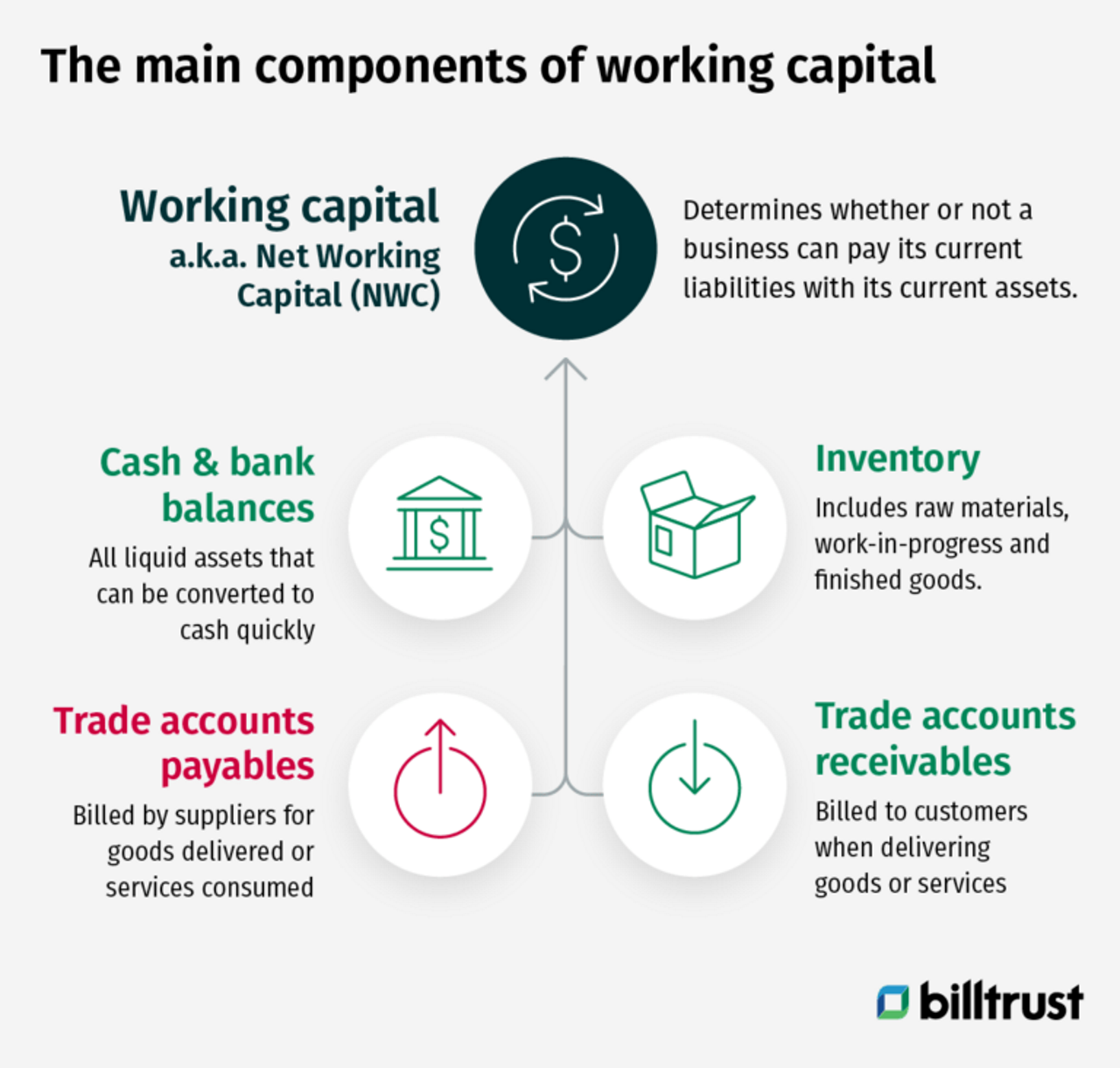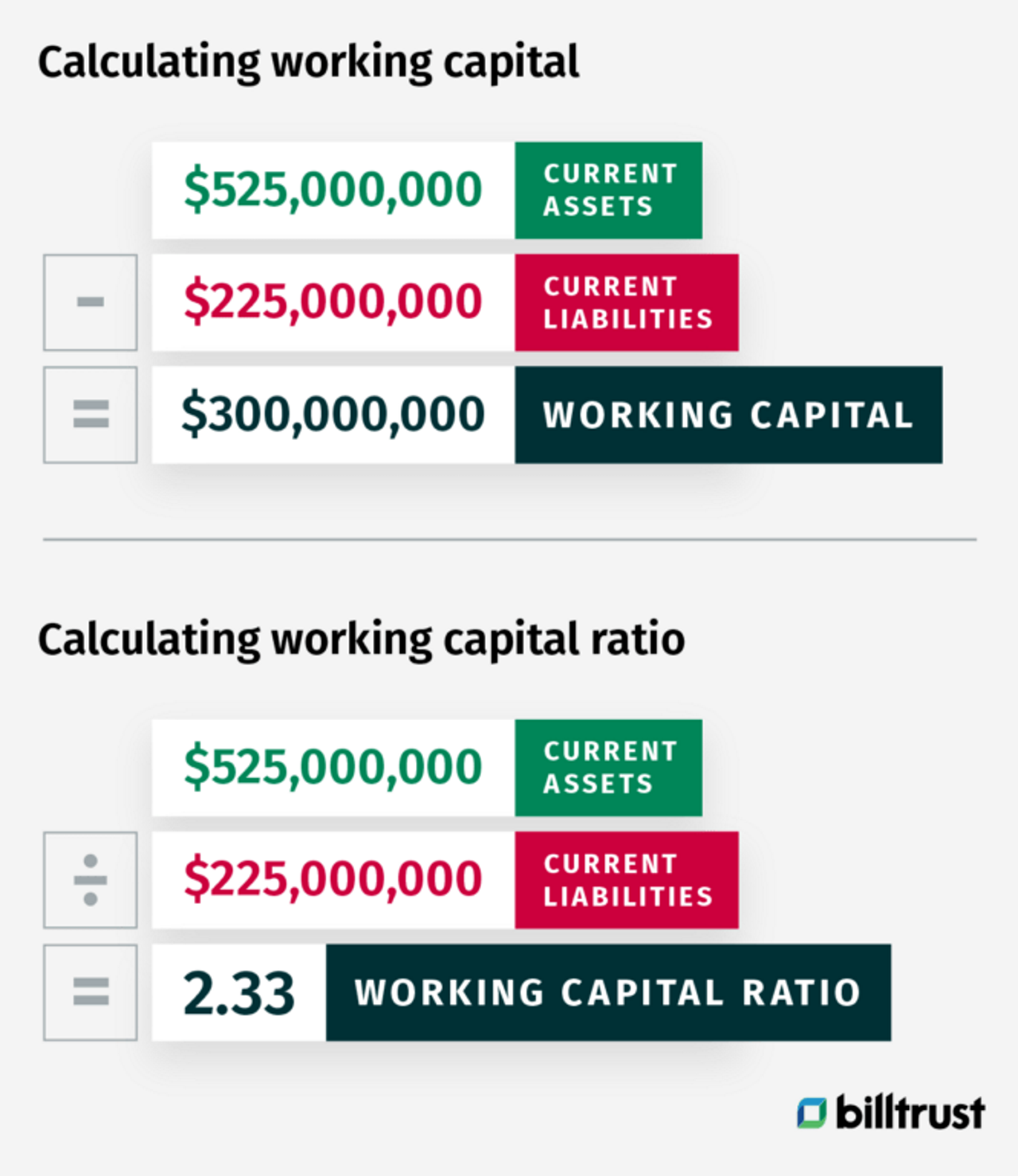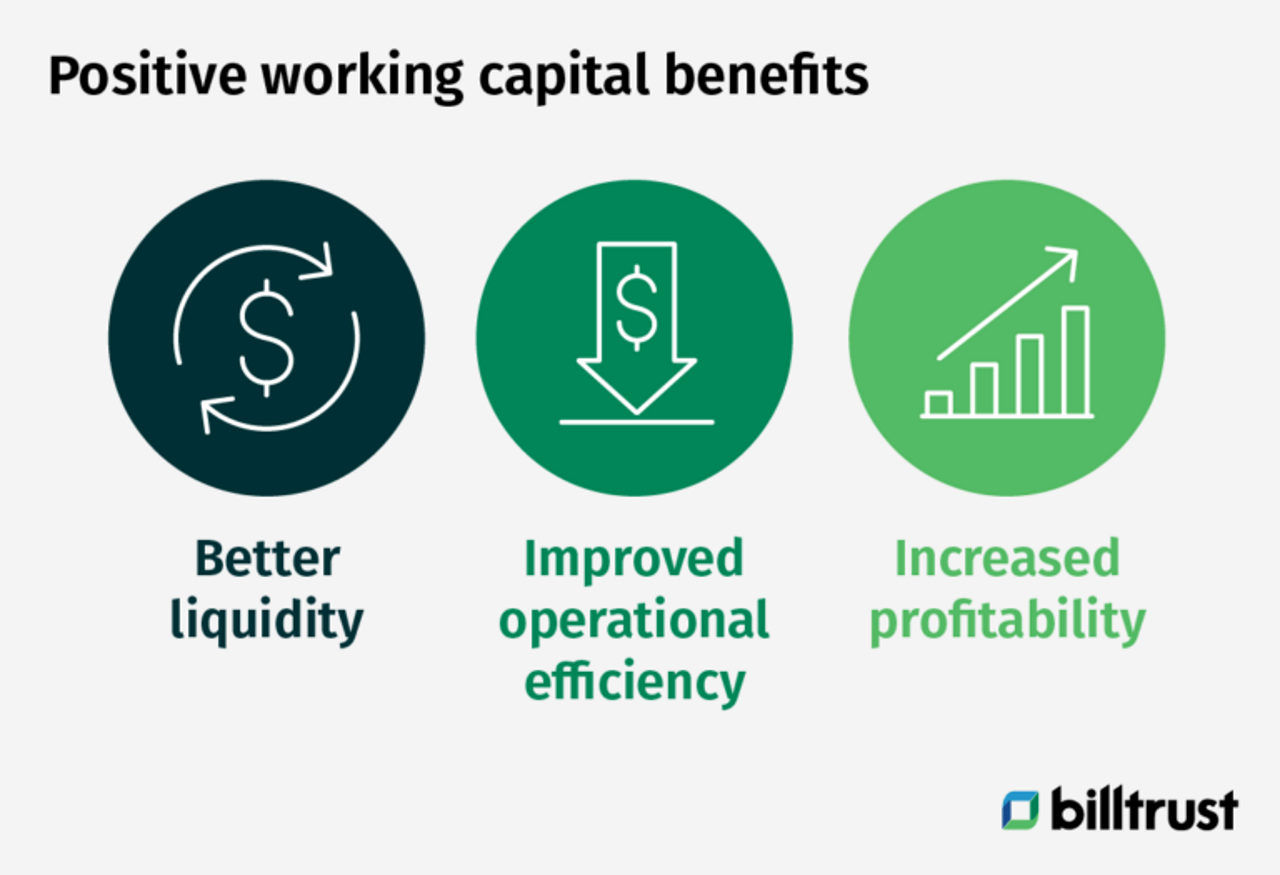Originally published January 2022, updated December 2024 with new examples and expanded information on working capital management types.
Do you know why businesses go bankrupt? It has nothing to do with profitability and everything to do with cash. Companies with insufficient cash flow to meet their payment obligations find themselves in serious trouble. Profitable and growing businesses, however, may also run out of money. They need significant working capital to support accounts receivable as they increase and additional investments. Knowing the ins and outs of working capital management can help your business avoid this crisis.
Read the blog → How to vet an AI solution: Guidance for finance leaders
Working capital and its main components
Working capital, also known as net working capital (NWC), determines whether or not a business can pay its current liabilities with its current assets. It gives a good indication of its short-term financial health, ability to clear debts within a year and operational efficiency.
Companies with positive working capital or NWC should have the ability to invest and grow. However, negative working capital usually means a company doesn’t have enough liquidity to pay its bills for the next 12 months. This is what happens when current assets don’t exceed current liabilities. A business will often have trouble paying back creditors and maintaining growth. The business may even go bankrupt.
Working capital has several main components: cash and bank balances, inventory, trade payables and trade receivables. Let’s examine each one of these.

Cash and bank balances
You probably know that cash is king and essential to current assets. However, all liquid assets that can be converted into cash quickly are crucial. Businesses need proper cash management to keep their working capital cycle in order. Plus, it allows companies to manage their operating cycle.
Companies must be aware of their free cash flow to the firm (FCFF) (profitability after all expenses and reinvestments) to manage cash flow as it contributes to business efficiency. Without proper cash usage, businesses may not reap trade discounts or improve their cash conversion cycle, a critical benchmark for analyzing the working capital cycle.
Inventory
Inventory makes up a significant portion of current assets and forms an integral part of working capital management. It includes raw materials, work-in-progress and finished goods. Businesses need good inventory management and control to have enough raw materials on hand to complete the finish stage of production. A business’ turnover of inventory is one of its primary sources of revenue generation and earnings for its shareholders.
A business can value its inventory in three ways: first-in, first-out, last-in, first-out and weighted average. Inventory management helps companies reduce inventory costs while creating or receiving goods as needed.
High inventory amounts for an extended period aren’t suitable for businesses because of the challenges, from storage and spoilage costs to obsolescence. Companies also want to avoid having too little inventory because they run the risk of losing sales and revenue from potential customers along with market share erosion.
Companies can use inventory management forecasting strategies, including the just-in-time (JIT) inventory system, to help them reduce their inventory costs. This means goods are created or received when necessary.
Trade Accounts Payables
Trade payables are amounts billed to a company by its suppliers for goods delivered or services consumed by a company. Billed amounts paid on credit are recorded in the accounts payable section of the business’ accounting software. Once recorded, they’ll appear in the accounts payable aging report until they’re paid. Monies owed to suppliers that are paid in cash aren’t considered trade payables because they’re no longer a liability.
Businesses must ensure their trade payable cycle is in alignment with the industry. If a company has a shortened trade payables cycle, it must keep more cash. This creates a longer trade cash conversion cycle and higher interest costs.
Businesses don’t want a more extended trade payable period to avoid paying vendors after long periods. Companies with a short trade receivable period can improve their cash conversion cycle, resulting in fewer working capital requirements and increasing profits.
Analysts review the payables turnover ratio to understand the impacts of the working capital management and to see if payments are timely. A high trade payables turnover ratio indicates that a business promptly pays its creditors. A ratio better than the industry average means a company is not taking advantage of credit terms allowed by its creditors, resulting in more cash.
Trade Accounts Receivables
Trade receivables are a serious part of current assets and working capital because they’re the amounts billed to customers when a company delivers goods or services. The billings are documented on invoices and summarized in an accounts receivable aging report. A collections team will use the report to collect overdue customer payments.
In a company’s general ledger, trade receivables are recorded in a separate accounts receivable account. They’re classified as current assets on the balance sheet when you expect to receive customer payments within one year of their billing dates.
Businesses should keep their trade receivables in alignment with their industry like trade payables. A lengthy trade receivables period results in delayed cash collection, impacting a business’ cash conversion cycle.
Keep in mind that when an analyst reviews a business, they look at the accounts receivable turnover ratio to understand its working capital management effectiveness. The number is a good indication of collecting payments for credit sales. It can also signal the amount of bad debt expense incurred by a business.
Why is working capital management important?
Working capital management refers to a business’s current assets minus its current liabilities. Company leaders use current assets and maintain ample cash flow to meet short-term goals and obligations.
Businesses can free up cash captured on their balance sheets by efficiently managing working capital. Because of this, leaders may decrease the need for external borrowing, fund mergers and acquisitions (M&A), invest in research and development (R&D) and increase their businesses.
Effectively managing working capital can mean the difference between staying in or going out of business. Cash must be available to cover known and unknown costs while using the funds available wisely. Companies achieve this by efficiently handling accounts payable, accounts receivable, inventory and cash.
Working capital management ratios and formulas
Net working capital (NWC) Is the difference between a business’s current assets and current liabilities. It shows finance leaders a company’s operational efficiency and short-term financial health.
Accountants, controllers and CFOs also review the working capital ratio (known as the current ratio) because it gives a good indication of a business’s liquidity. The working capital ratio is calculated by dividing current assets by current liabilities. For that reason, it can also be called the current ratio. It is a measure of liquidity, meaning the business can meet its payment obligations as they fall due.
Let’s use a staffing agency to demonstrate these working capital formulas.

How to calculate working capital management for a staffing agency
Below are the formulas to calculate your net working capital and working capital ratio.
Net working capital
Current assets: cash and cash equivalents, trade accounts receivables and property, equipment and leasehold improvements
Current liabilities: accounts payable, accrued salaries and wages, accrued income taxes and accrued payroll taxes and employee benefits, short-term debt
$525,000,000 – Current assets
– $225,000,000 – Current liabilities
$300,000,000 – Working capital – cash, operating expenses, short-term debt
Working capital ratio
Current assets / current liabilities
$525,000,000 / $225,000,000 = 2.33
The higher the ratio, means you have more cash on hand and greater flexibility to expand your business, or in this case, your staffing agency. If the ratio decreases, your finance team must understand why. The ideal ratio is based on industry standards and your business’ circumstances. However, if it’s less than or slightly higher than 1.0, your business may still have a problem paying its bills. The ideal ratio is between 1.2 and 2. But if yours is too high, it may
signal that your business (or staffing agency) is holding too much cash instead of investing it back into the business to generate growth.
The top strategies to improve working capital
Businesses can use a variety of approaches to support their working capital management for themselves and their suppliers. Here are some ideas and essentials of working capital excellence to avoid negative impacts.
Accounts receivable management
What is accounts receivable? It’s the money a business is owed by its customers for goods or services that have been delivered but not yet paid for. A company sells goods or services to customers on credit to expand its sales. But there’s an element of risk involved–the risk of bad debt expense. This is why your business must manage its AR to improve its return on receivables.
Even though an excessive investment in accounts receivable (AR) increases sales, it leads to a high risk of bad debts. The same is true when there’s an inadequate amount of accounts receivable because it reduces sales and risks bad debts. Your accounting or finance department must weigh the benefits and costs of maintaining accounts receivable and report their findings to your controller and CFO.
Better credit management practices, including a clear credit and collection policy, strong credit standards, credit terms, analysis of customers’ credit risk, and discounts, can positively impact your receivables. Also, giving your credit managers access to the latest technologies can help them make the best decisions possible.
Remember that an integrated receivables solution can help your business manage receivables effectively, reduce the number of manual tasks, and improve your AR process. Monitoring your AR turnover can help you learn whether or not your customers are paying you on time and according to your credit terms. And don’t forget that accounts receivable is like discovering found money, which you could use to grow your business.
Cash flow management
Cash on your company’s balance sheet is the most liquid of assets; bank deposits, checks,
coins, currency and drafts make up the cash. Current assets like accounts receivable and inventory are converted into cash eventually. It also includes marketable securities which get converted into cash. This is why cash management is critical to your business’s financial health and working capital.
Your business should have a significant amount of current assets at all times. However, cash should not be inadequate because it can hold production. An excessive amount of cash on hand can impact the growth and profitability of your business. Therefore, you must manage your cash flow to manage your working capital to ensure you can make payments and reduce idle cash. Here are a few cash management strategies to manage your cash flow more effectively:
- Prepare cash budgets to project cash flows (accounts payable and accounts receivable) so that you can plan and control your use of cash and make better decisions on how to use any surpluses or address any deficits.
- Compare risk with profitability to determine the ideal level of your business’ cash balance. Financial analysts can use various methods to determine the optimal level of cash. These include the economic-order quantity (EOQ) formula used in inventory decisions, the stochastic and probability models.
Inventory management
Inventory includes finished goods that your business offers for sale and components that form part of finished goods (raw materials, work in progress, etc.). The type of inventories your business may stock or the number of components it stocks depends on your business. Because of this, inventory management plays an essential part in current asset management.
Your business must have an optimal amount of working capital in inventories, meaning that the investment can’t be too low or too high if it’s low, the product process stalls. If it’s too high, it leads to a blockage of funds. Your business’ inventories shouldn’t be inadequate or excessive. Therefore, you must determine and maintain the proper level of stock. Analysts can use the following techniques to ensure the appropriate amount of inventory for your business:
- ABC analysis
- Economic order quantity
- Inventory turnover ratio
- Just in time inventory
Without proper inventory management, your working capital and business will suffer. Your competitors can gain market share, or you may have to file bankruptcy or, worse, go out of business. Don’t let this happen. Ensure that your inventory management is accurate and take advantage of technologies, i.e., artificial intelligence and machine learning, that can help you to
Invoice management
Invoice automation can help to improve a business’ working capital by streamlining the invoicing process. Not only does it reduce the risk of errors caused by manual methods, but it can ensure that your customers receive your invoices on time. This means you can get paid faster. Electronic invoices also allow companies to convert purchase orders into invoices automatically or submit high volumes of invoices with a system-to-system interface.
According to the May 2020 Forrester analysis, AR invoicing automation has transformed from a “nice-to-have” technology into a business necessity. Plus, the capabilities of invoicing software matter. Because of the trend towards accounts payable automation, one segment of buyers requires suppliers to enter invoices into portals, while others still use paper invoices. The most effective invoicing automation vendor needs to interface with all buyer portals, handle printing and mailing invoices. They also must help suppliers convince their buyers to accept electronic invoices.
Because manual processes (and slow USPS deliveries) can disrupt cash flow, thus impacting working capital. Invoice management has become a must-have. The quicker invoices are sent, the better your business’s cash flow and financial health are.
Supply chain finance management
Supply chain finance, known as reverse factoring, offers suppliers early payments through one or more third-party funders, i.e., banks or other financial providers. It’s a way for them to improve their DSO by getting paid sooner at a low cost of funding. Buyers can protect their working capital by paying the agreed payment terms.
Supply chain finance works better when buyers have better credit ratings than sellers because they can get capital from a financial institution at a lower cost. Buyers can negotiate better terms from sellers, including extended payment schedules. Sellers can off-load their products faster and receive immediate payment from the go-between financial institution.
The complicated accounting and capital structure associated with supply chain finance have recently decreased because of the increased regulatory and reporting requirements.
Read the blog → Streamline your workflow with an invoice processing platform
Benefits of positive working capital in your organization
Now that you have working capital management strategies let’s explore the key benefits of optimizing working capital for your business.

Better liquidity
By having a high level of working capital, your business can ensure cash available for any unexpected or upcoming opportunities. It also gives you more control over how you run your company, which means you can quickly fulfill customer orders, invest and expand in new products or services faster.
Improved operational efficiency
Optimal working capital management means your company can avoid any present or future hindrances in its operations. You have a safety net to protect your business against customer late payments or the lack of production.
Increased profitability
When your accounts payable and accounts receivable operate productively, your business will have a high level of working capital. Your AP team must pay the company’s bills on time for this to happen, taking advantage of early payment discounts. On the accounts receivable side, your AR team must ensure that invoices are sent out immediately and that payments are applied quickly. This provides a steady flow of cash.
How strong is your business’s capital management?
Organizations strive to have a high level of working capital because it signifies that a company is financially healthy and has the opportunity for growth. This is why working capital management is critical for assessing the long-term financial health of a business. Maintaining strong cash flow is a must for your business to meet its short-term obligations. A solid financial position is critical to your business operations during economic uncertainty. Therefore, managing working capital effectively should be a top priority for a chief financial officer (CFO), controller and accounting and finance managers.
Where expertise meets innovation
Billtrust delivers the market’s leading unified accounts receivable platform, empowering finance leaders to transform their order-to-cash processes. Our comprehensive suite of solutions helps businesses control costs, accelerate cash flow, and enhance customer satisfaction through intelligent automation.
Our end-to-end platform unifies credit, invoicing, payments, cash application, and collections into a single, powerful solution. By streamlining these critical functions, we help organizations reduce manual work, improve accuracy, and make more strategic financial decisions.
Unlike point solutions that address individual AR processes, Billtrust’s integrated approach delivers greater efficiency, better visibility, and measurable results across the entire order-to-cash cycle.









